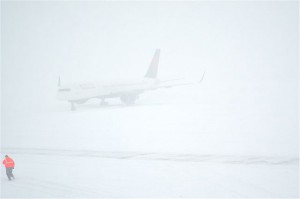When strategy meets the storm
Just before the blizzard that crippled a significant portion of the East Coast, I was returning from a business trip. I did eventually make it home, but the return flight included a bonus three-day layover in Charlotte, NC.
I’ll spare you many of the details, but a few key events and situations really stand out from that trip. The lessons learned are applicable to any corporate strategy, content or not.
Protocols that look good on paper may not fare well in practice
Every strategy can be broken down into a series of protocols that need to be followed. Which protocols you follow will change based on the situation, but they all feed into the overarching strategy that drives your business goals.
Many of these protocols are designed to account for specific situations. However, following them to the letter every time may do more harm than good. A certain amount of discretion is needed to alter protocol to effectively handle tricky situations.
My flight home began without incident. We boarded on time, and were set to take off with a full flight. After everyone was seated, a flight attendant made an announcement: five people needed to volunteer their seats for additional crew members due to the impending East Coast storm. Volunteers would be given an alternate flight and a voucher toward future travel.
As you could imagine, no one came forward. We were all concerned about the storm, and wanted to get to our destinations before we were stranded. The airline’s protocol called for volunteerism, and so we sat for an hour waiting for volunteers, which stirred great concern among the passengers and caused many to ultimately miss their connections. Finally, an executive decision was made by either the airline or crew to deplane the last people to purchase tickets, board the additional crew, and finally take off. But by then it was too late; many of us missed our connecting flights and were stuck to ride out the storm on an extended layover.
While the proper protocol to solicit volunteers might work in normal situations, the storm factor should have allowed for other creative solutions–or at least a shorter timeline between asking for volunteers and removing the last few ticket holders from the plane. The crew would have boarded, the majority of passengers would have made their connections, and fewer people would have been stranded. Following protocol in this case caused more harm than good; customers were upset, customers were stranded (so many that the airline ran out of available hotels), and stranded customers now required new flights in an already chaotic backlog due to cancellations.
When load testing meets reality
Implementing any system requires a great deal of testing and tweaking. But true testing doesn’t begin until you’re using it live and encountering unforeseen or extreme situations. After launching a new system, it’s important to also have failsafes in place when (not if) the unforeseeable happens. Fallback systems are great, but two of the best failsafes to use are human communication and collaboration.
On the day of my final flight home, the flight situation was understandably a nightmare. The airports on the East Coast were finally re-opening after their storm shutdowns, flights were still being cancelled and delayed due to weather conditions and missing crew, and displaced passengers were very unhappy.
As I queued in the very long customer service line, I also called the main customer service number. There was an hour wait on the phone, so I opted for a call-back when it was my turn to talk to an agent. Meanwhile I made it to the service counter and began looking for earlier direct flights home. We found one, but it was full. I asked about standby, and after much fiddling with the system, the agent gave up. She could not put me on standby without voiding my later, valid ticket. (!!!)
I begrudgingly kept my later flight and went off in search for coffee. Then I received a callback from the support line. They confirmed that I actually was on the standby list for the early flight, and that my other ticket was still valid should I not make it on the earlier flight.
I quickly gathered my belongings and headed to the gate to confirm. Alas, their system did not show me on standby. But this agent worked some voodoo magic and was able to get me on standby and retain my later flight as backup.
Obviously there was a breakdown in systems communication between the airline’s main system and the airport hubs, and the local agents were left to flail about their work as best they could. For some reason, they could not contact someone to confirm these differences, nor to troubleshoot or even report a system error. There needs to be a communication bridge between those using the system and those managing it.
People are your greatest corporate asset
So in the end, I made it home on that earlier flight. My standby status earned me a seat just before boarding began. It was all thanks to that one gate agent who ensured that their local systems showed that I was both on standby and had a valid later flight if needed. She truly went above and beyond, checking in on me from time to time and even rooting for me as my name climbed higher on the standby list.
There are details about this horrible trip that I won’t forget. Some are mentioned in this post, and others are best left unmentioned to hopefully fade with time. But what I may never forget is that one gate agent’s actions, from her refusal to let a system glitch prevent her from doing what should normally be doable to the high-five she gave me as I boarded my flight.
Technology fails happen. Unforeseeable events happen that can shake normal workflows. In fact, I’m sure that other airlines had issues during this storm. But it’s the human to human interaction that can build or destroy a customer’s impression of a company. Empower your workforce to put their best foot forward, and do everything possible to enable them to creatively solve problems when needed. It just might be your only saving grace with an unhappy customer.





Leigh White
Great post! I could also add that perhaps at some desperate point the protocols need to be thrown out the window and heroic action taken…such as renting a car and driving home! (Which I have done on more than one occasion.) Your post was a refreshing example of making lemonade from lemons…or perhaps blog from blargh 🙂
Bill Swallow
I thought about driving, but it would have been incredibly long and I would have driven right into (though hopefully through) the worst of it.